
The Garden of Serenity or Jingyuan (靜園) is a museum [1] and former residence of Puyi, the last emperor of China in Tianjin, China. [2]

The Garden of Serenity or Jingyuan (靜園) is a museum [1] and former residence of Puyi, the last emperor of China in Tianjin, China. [2]
Located at 70 Anshan Road (then Miyajima Road) in the then Tianjin Japanese Concession, the Garden of Serenity was the residence of Lu Zongyu, a warlord and a member of the Senate during the Republican era. In 1929, Puyi moved to the villa and changed the name to "Jingyuan''. Puyi lived there until 1931 before moving to Manchukuo.

The building was later used for offices and was subsequently renovated and changed with parts of the Garden of Serenity being demolished. [3] [4] Buildings added to Garden of Serenity after Puyi's departure were later demolished in the 2000s in an attempt to restore the building to its previous appearance during the 1920s and 1930s before becoming a museum. [4] Today the museum displays exhibits and displays relating to Puyi, the last emperor of China [1]

Puyi was the last emperor of China, reigning as the eleventh and final monarch of the Qing dynasty. In 1908, when the Guangxu Emperor died without an heir, Empress Dowager Cixi picked his nephew Puyi, aged two, to succeed him as the Xuantong Emperor. Puyi's father, Zaifeng, Prince Chun, served as regent for his son before Puyi was forced to abdicate in 1912 as a result of the Xinhai Revolution, which ended two millennia of imperial rule and established the Republic of China.

The Forbidden City is the imperial palace complex in the center of the Imperial City in Beijing, China. It was the residence of 24 Ming and Qing dynasty Emperors, and the center of political power in China for over 500 years from 1420 to 1924. The palace is now administered by the Palace Museum. As a UNESCO World Heritage Site, it is one of the most popular tourist attractions in the world. The Forbidden City is arguably the most famous palace in all of Chinese history, and is the largest preserved royal palace complex still standing in the world.
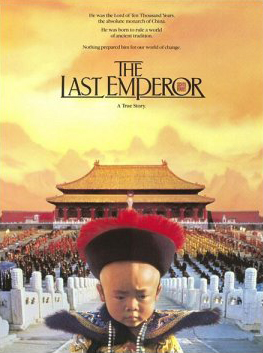
The Last Emperor is a 1987 epic biographical drama film about the life of Puyi, the last Emperor of China. It is directed by Bernardo Bertolucci from a screenplay he co-wrote with Mark Peploe, which was adapted from Puyi's 1964 autobiography, and independently produced by Jeremy Thomas.
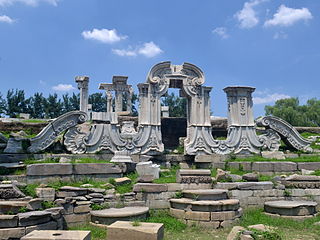
The Old Summer Palace, also known as Yuanmingyuan or Yuanmingyuan Park, originally called the Imperial Gardens, and sometimes called the Winter Palace, was a complex of palaces and gardens in present-day Haidian District, Beijing, China. It is 8 kilometres (5 mi) north-west of the walls of the former Imperial City section of Beijing. Widely perceived as the pinnacle work of Chinese imperial garden and palace design, the Old Summer Palace was known for its extensive collection of gardens, its building architecture and numerous art and historical treasures. Constructed throughout the 18th and early 19th centuries, the Old Summer Palace was the main imperial residence of the Qianlong Emperor of the Qing dynasty and his successors, and where they handled state affairs; the Forbidden City was used for formal ceremonies. The Garden was reputed as the "Garden of Gardens" in its heyday was "arguably the greatest concentration of historic treasures in the world, dating and representing a full 5,000 years of an ancient civilization", according to Robert McGee, chaplain to the British forces.

Zaifeng, also known as Tsai Feng, Prince of Ch'ün, formally known by his title Prince Chun, was a Manchu prince and regent of the late Qing dynasty. He was a son of Yixuan, the seventh son of the Daoguang Emperor, and the father of Puyi, the Last Emperor. He served as prince regent from 1908 to 1911 during the reign of his son until the Qing dynasty was overthrown by the Xinhai Revolution in 1911.

Wenxiu, also known as Consort Shu (淑妃) and Ailian (愛蓮), was a consort of Puyi, the last Emperor of China and final ruler of the Qing dynasty. She was from the Mongol Erdet (額爾德特) clan and her family was under the Bordered Yellow Banner of the Eight Banners.

Imperial Noble Consort Wenjing, also known as Dowager Imperial Noble Consort Duankang, of the Manchu Bordered Red Banner Tatara clan, was a consort of the Guangxu Emperor.
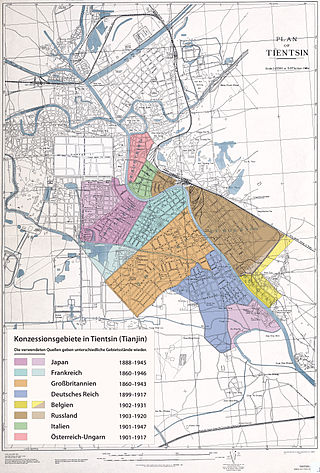
The foreign concessions in Tianjin were concession territories ceded by the Qing dynasty to a number of European countries, the United States and Japan within the city of Tianjin. There were altogether nine foreign concessions in old Tianjin on the eve of World War II. These concessions also contributed to the rapid development of Tianjin from the early to mid-20th century. The first foreign concessions in Tianjin were granted in 1860. By 1943, all the foreign concessions, except the Japanese concession, had ceased to exist de facto.

The Museum of the Imperial Palace of Manchukuo is a museum in the northeastern corner of Changchun, Jilin province, northeast China. The palace was the official residence created by the Imperial Japanese Army for China's last emperor Puyi to live in as part of his role as Emperor of the Japanese puppet state of Manchukuo. In the People's Republic of China the structures are generally referred to as the Puppet Emperor's Palace & Exhibition Hall. It is classified as a AAAAA scenic area by the China National Tourism Administration.

Wanrong, of the Manchu Plain White Banner Gobulo clan, was the wife and empress consort of Puyi, the last emperor of China. She is sometimes anachronistically called the Xuantong Empress, referring to Puyi's era name. She was the titular empress consort of the former Qing dynasty from their marriage in 1922 until the exile of the imperial family in November 1924. She later became the empress consort of the Japanese puppet state of Manchukuo in northeastern China from 1934 until the abolition of the monarchy in August 1945, at the conclusion of the Second World War. She was posthumously honored with the title Empress Xiaokemin.
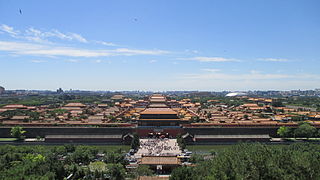
The Forbidden City was first built in the early-15th century as the palace of the Ming emperors of China. It is located in the centre of Beijing, China, and was the Chinese imperial palace from the early-Ming dynasty in 1420 to the end of the Qing dynasty in 1912, continuing to be home of the last emperor, Puyi, until 1924, since then it has been a museum.

Isabel Ingram Mayer, née Ingram was an American tutor to Wanrong, the empress consort of China of Puyi, the last emperor of China.
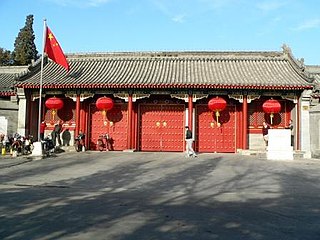
Prince Chun's Mansion, also known as the Northern Mansion, is a large residence in the siheyuan style with lavish private garden located near the Shichahai neighborhood in central Beijing. The grounds had been part of a villa built by Mingju, an official in the court of the Kangxi Emperor. It was later be seized by Heshen, a favorite of the Qianlong Emperor, and following Heshen's purge and execution in 1799, it was bestowed on Yongxing by his brother the Jiaqing Emperor, and the mansion was renovated. The mansion would change hands several times, eventually ending up as the residence of a minor Qing official named Yusu. In 1888, it was granted to Yixuan, the biological father of the Guangxu Emperor, by his sister-in-law, Empress Dowager Cixi. In 1891, the Yixuan died, and his title and mansion were inherited by his second surviving son, Zaifeng; Zaifeng's own eldest son, Puyi, the last Qing emperor, was born at this mansion in 1906.

Yunying (1913–1992), better known as Jin Yunying, was a Chinese princess of the Qing dynasty.
Five Great Avenues is a tourist and up-scale residential area in Heping District, Tianjin, China.

The Italian concession of Tianjin was a small territory (concession) in central Tianjin, China, controlled by the Kingdom of Italy between 1901 and 1943, officially ceded to China in 1947.
Jia Yinghua was a Chinese writer and researcher who focused on the late Qing dynasty. He served as Vice President of the Biography Society of China, commissioner of National Commission of the Chinese Writers’ Association, President of China's Electrical Power Writers' Association. Representative works of his include The Later Half of the Last Emperor's Life, The Last Eunuch of China: The Life of Sun Yaoting, The Last Emperor’s Brother: The Life of Pujie.
Puyi, the last emperor of China, came from a long noble ancestry. During the course of his three terms as emperor, and during post war life, he had five wives and numerous consorts.

The Zhang Garden or Zhangyuan (張園) is a European-style former garrison building in Tianijn, China built in the 1930s. Prior to construction of the garrison building the site contained a mansion residence, built in 1916 in the Japanese Concession of Tianjin by Zhang Biao, a former high-ranking official in the Qing Court. The mansion served as a temporary home for both Sun Yat-sen, the first president of the Republic of China, who briefly resided there in 1924, as well as Puyi, the last Emperor of the Qing Dynasty, who lived in the now demolished mansion from 1925 until 1929

Tieliang, courtesy name Baochen (寶臣), was a member of Bordered White Banner, a general in the late Qing dynasty and one of the main members of the Royalist Party.